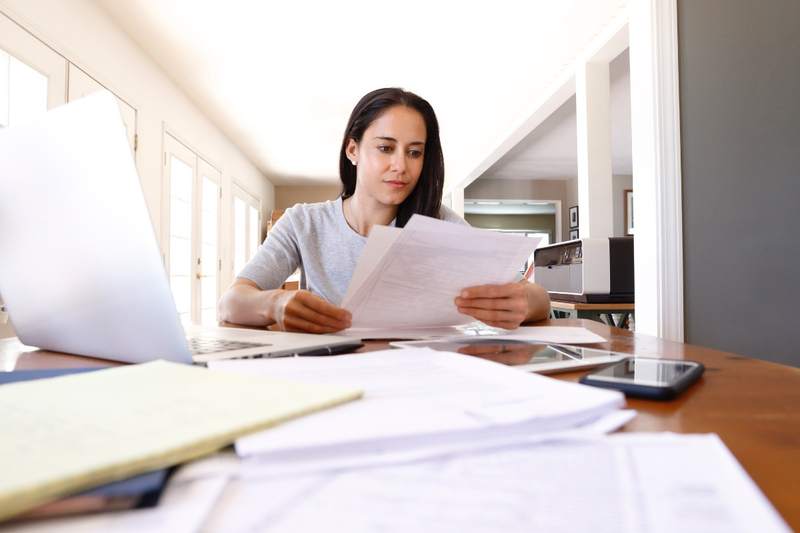When you get a mortgage, you need to make a payment toward that loan every month. On your bill, you’ll see a few line items, including escrow, interest, and principal.
Principal is the amount that you borrowed with a mortgage loan and must pay back to your lender. With each payment, your principal will reduce until the loan is paid off.
Understanding how principal works — and how it impacts your monthly payment — can help you understand the best way to handle your mortgage.
Key Takeaways:
- Mortgage principal is the amount you borrowed as a loan, whereas mortgage interest is the cost of borrowing the principal.
- Beyond principal and interest, your monthly payment usually also includes taxes and insurance.
- Mortgage amortization is the process of progressively paying more toward principal and less toward interest over time.
Mortgage Principal Defined
The principal of any loan is the amount of money that you borrowed and must pay back. For example, if you borrowed $300,000 to buy a home, your mortgage principal is $300,000. Once you pay back half the mortgage, the principal balance will be $150,000.
Principal is one portion of your monthly mortgage payment. Your lender will also charge interest, which is the cost of borrowing money. You’ll likely need to pay property taxes and other costs, such as insurance, as well.
Mortgage Principal vs. Mortgage Interest
Mortgage principal and mortgage interest are closely related. Interest is the cost of borrowing the principal, and is expressed as a percentage rate. The amount of interest that accrues on your loan depends on the interest rate and the remaining principal.
How is your mortgage interest rate calculated?
Your lender sets your mortgage interest rate when you first receive the loan. Your interest rate is based on several personal factors, including:
- Your credit score.
- The location of the home.
- The loan amount.
- The loan term.
- The loan type.
- The size of your down payment.
- Whether the interest rate is fixed or adjustable.
Your interest rate is also influenced by factors that are outside of your control. These factors include the federal funds rate and changes in lending regulations.
Understanding all these factors can help you work toward securing a low interest rate, which is key to having lower monthly payments.
Mortgage Principal vs. Total Monthly Payment
Mortgage principal is just one portion of your total monthly payment.
How is your total monthly payment calculated?
Your lender will calculate your monthly payment by adding up the following costs:
- Principal. Each monthly payment will pay off a portion of the loan’s principal, slowly reducing the balance until it’s paid off.
- Interest. Each monthly payment must cover all the interest that accrued since the last payment.
- Private mortgage insurance. Depending on the type of mortgage you get and your loan-to-value ratio, you may have to pay for PMI as part of your monthly payment.
- Property taxes. These taxes are charged by local governments, and lenders typically require borrowers to include them with each monthly payment. In some cases, you can avoid adding property taxes to your monthly payment by opting out of escrow, but you’re still responsible for paying them to your local government.
- Homeowners insurance. Nearly all lenders require that you carry homeowners insurance to protect your home. You may have to pay for coverage through an escrow account, adding the cost of insurance to your monthly mortgage payments.
How Is Your Amortization Schedule Affected By Principal Payments?
Amortization is the process through which you pay off a loan by making monthly payments.
Each payment you make reduces the principal balance of the loan and covers accrued interest. Because the amount of interest that accrues depends on the principal balance, reducing your principal means that less interest will accrue over the next month.
With each subsequent payment, more of your money will go toward paying down principal, and less will go toward covering interest charges. In other words, principal reduces slowly at first, and more quickly as you near the end of the loan term.
“An amortization schedule gives you a visual countdown to the end of your mortgage,” says Ryan Hawker, CEO of H3 Homebuyers, a Xenia, Ohio-based real estate investment company. “It’s a table or chart that shows the amount of each payment that will go toward principal and interest until your house payoff.”
Check out this sample amortization table for a $400,000 loan with a repayment term of 30 years and a fixed interest rate of 7%:
Amortization Calculation Example
| Month | Payment Amount | Principal Payment | Interest Payment | Principal Balance |
| 1 | $2,661 | $327.88 | $2,333.33 | $399,672.12 |
| 12 | $2,661 | $349.54 | $2,311.67 | $395,936.76 |
| 60 | $2,661 | $462.11 | $2,199.10 | $376,526.36 |
| 120 | $2,661 | $655.10 | $2,006.11 | $343,249.53 |
| 180 | $2,661 | $928.69 | $1,732.52 | $296,075.46 |
| 240 | $2,661 | $1,316.53 | $1,344.68 | $229,200 |
| 300 | $2,661 | $1,866.34 | $794.87 | $134,396.41 |
| 360 | $2,661 | $2,645.78 | $15.43 | $0 |
Can You Make Extra Payments Toward Your Principal?
It’s possible to make extra payments toward your loan’s principal. These additional payments help reduce the overall cost of the loan and let you pay it off more quickly.
For example, if you have a 30-year fixed-rate mortgage for $400,000 at a 7% interest rate, the monthly principal and interest payment would be $2,661.21. If you choose to make an additional $400 payment each month, you would save $202,029 over the life of the loan and pay it off nine years and five months early.
There are several ways to make extra payments toward your principal, including:
- Make smaller principal-only payments on a recurring basis.
- Make one large additional payment toward principal every year.
- Pay half of your monthly mortgage payment amount every two weeks, which means you’ll end up making 13 months’ worth of mortgage payments over a year.
- Round up your monthly mortgage payment to the nearest $100 and pay the difference toward the principal.
- Work with your lender to combine the methods previously mentioned.
It’s important to communicate with your lender that these extra payments should go toward your principal, not interest.
“Reducing your mortgage principal quickly generally requires making larger-than-required payments each month,” says Martin Orefice, CEO of Rent To Own Labs, an Orlando, Florida-based real estate company. “It can be necessary with some lenders to specify that you’re making extra payments toward the principal balance, rather than on interest, so make sure you carefully read the payment options.”
Mortgage Principal FAQ
Here are some frequently asked questions about mortgage principal.
One way your principal can change is with a payment-option ARM, which is an adjustable-rate mortgage with different payment choices. One of these choices is to make minimum payments that don’t fully cover the interest, and have any unpaid interest added to your principal balance. In this scenario, you risk paying interest on interest.
Yes, your total monthly payment can change with a fixed-rate mortgage. Changes to your insurance or property taxes could cause your monthly payment to increase or decrease.
Your first mortgage payment is typically due on the first of the month, one full month after the closing date. You can review your loan documents to see the exact due date of the first loan payment.
A loan’s annual percentage rate is an expression of its interest rate and other costs of borrowing the principal. Compared to an interest rate, an APR provides a more complete picture of how much it costs to borrow money.
The Bottom Line on Mortgage Principal
Your mortgage principal is the outstanding balance of your loan and the amount you ultimately have to pay back. Principal affects the interest that accrues and influences your loan’s monthly payment. Understanding mortgage principal helps you decide how much home you can afford and stay on top of your monthly payments.
More From LowerMyBills:
- How To Lower Your Monthly Mortgage Payment
- Why Are Mortgage Interest Rates Important?
- Pros and Cons of Buying a Home When Interest Rates Are High
- What Is PMI, and How Do You Avoid It?
- Homeowners Insurance Guide: Coverage, Cost, and Tips for Purchasing
- How Do Property Taxes Work?
- Escrow Account Basics for First-Time Homebuyers






